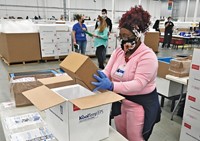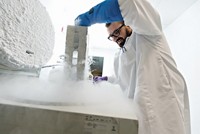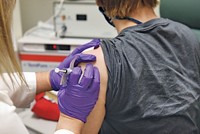Advertisement
Grab your lab coat. Let's get started
Welcome!
Welcome!
Create an account below to get 6 C&EN articles per month, receive newsletters and more - all free.
It seems this is your first time logging in online. Please enter the following information to continue.
As an ACS member you automatically get access to this site. All we need is few more details to create your reading experience.
Not you? Sign in with a different account.
Not you? Sign in with a different account.
ERROR 1
ERROR 1
ERROR 2
ERROR 2
ERROR 2
ERROR 2
ERROR 2
Password and Confirm password must match.
If you have an ACS member number, please enter it here so we can link this account to your membership. (optional)
ERROR 2
ACS values your privacy. By submitting your information, you are gaining access to C&EN and subscribing to our weekly newsletter. We use the information you provide to make your reading experience better, and we will never sell your data to third party members.
Support nonprofit science journalism
C&EN has made this story and all of its coverage of the coronavirus epidemic freely available during the outbreak to keep the public informed. To support us:
Donate Join Subscribe
Vaccines
Covid-19
Moderna’s COVID-19 vaccine to roll out across the US
It’s the second mRNA vaccine for COVID-19 authorized for emergency use by the FDA
by Ryan Cross
December 21, 2020

A second vaccine has joined the fight against the coronavirus in the US. This week, healthcare workers will get to roll up their sleeves for a shot of Moderna’s COVID-19 vaccine, which the US Food and Drug Administration greenlit for emergency use authorization (EUA) the evening of Dec. 18. FedEx and UPS trucks began delivering the first crates of vaccines over the weekend, with 20 million doses expected to be delivered to the US government by the end of the year.
“We can finally see the light at the end of the tunnel,” says Colleen Kelley, an infectious disease physician at the Emory University School of Medicine, who was a principal investigator for Moderna’s Phase 3 clinical trial of the vaccine. “People should have hope. These vaccines and the ones coming down the pike in clinical trials have the potential to change the world and get us back to normal everyday life. Now it is a question of scale-up and implementation.”
Moderna says it will supply up to 100 million doses of its vaccine in the US by the end of March—enough to vaccinate 50 million people with the required two shots, administered four weeks apart. The US had ordered another 100 million doses of Moderna’s vaccine, plus 100 million doses of the similar Pfizer-BioNTech COVID-19 vaccine, which was authorized on Dec. 11 and first rolled out to healthcare workers on Dec. 14.
Anita McElroy, a pediatric infectious disease physician at UPMC Children’s Hospital of Pittsburgh, called the authorized vaccines a “huge scientific achievement,” although she noted that these two vaccines alone “won’t be sufficient” to end the pandemic. “We’ll need more vaccines from additional manufacturers,” she says in an email to C&EN.
FDA authorized Moderna’s vaccine a day after its vaccine advisory committee voted 20-0 that the benefits of vaccination outweighed the risks in people ages 18 and up. At that meeting, on Dec. 17, Moderna presented data from its 30,000 person clinical trial showing that the vaccine was 94.1% effective at preventing COVID-19, based on 185 cases of the disease in the placebo group compared to only 11 among those who got the vaccine. A week before, Pfizer showed that its vaccine was 95% effective in a trial of 44,000 people.
“We were hoping for 70 to 80% efficacy, so the 94 to 95% efficacy was a bit surprising,” says Tony Moody, an infectious disease doctor and Director of the Laboratory of B cell Immunotechnology at the Duke Human Vaccine Institute. Emory’s Kelly was also “super excited” about the high level of efficacy. “I don’t think anyone expected something so close perfection,” she says, especially in a new vaccine technology.
The Moderna and Pfizer-BioNTech shots are both messenger RNA (mRNA) vaccines that contain genetic instructions that tell our cells to temporarily make the coronavirus spike protein. Since the virus uses that protein to infect our cells, the vaccine gives our immune systems target practice so that antibodies and T cells can quickly tackle the virus. “Everyone in vaccinology has been excited about the prospects of the technology because it just seems so logical,” Kelley says about mRNA vaccines.
BioNTech, founded in 2008, and Moderna, founded in 2010, have invested billions in mRNA vaccine technology over the past decade. Their COVID-19 shots were the first mRNA vaccines to be tested in Phase 3 studies, and are now the first authorized vaccines based on the technology. Wayne Koff, president and CEO of the Human Vaccines Project, says in an email to C&EN that the FDA authorizations are a “tremendous accomplishment” for both vaccines, and that “the future is very bright” for mRNA vaccines in general. Arcturus Therapeutics, CureVac, Imperial College London, and Translate Bio—in partnership with Sanofi—all have their own mRNA vaccines for COVID-19 in the works.
Drew Weissman, an mRNA vaccine scientist at the University of Pennsylvania, feels that his work has been “vindicated.” In 2005, Weissman and his colleague Katalin Karikó—who is now at BioNTech—developed a strategy for using a chemically-modified nucleoside in mRNA vaccines to prevent the immune system from attacking the mRNA itself. That approach is used in both the Pfizer-BioNTech and Moderna vaccines. “Kati and I fought for modified-mRNA for 15 years. It is very gratifying to see it used to help people,” he says in an email to C&EN.
Scientists note that there are still some unanswered questions about the two vaccines. Although both shots are effective at preventing COVID-19 disease, it unclear how effective they are at preventing asymptomatic transmission. The companies are collecting data to answer that question.
Neither vaccine has been tested in people that are pregnant or that have compromised immune systems, although additional studies are planned. Pfizer and Moderna are both planning further tests of their vaccines in children aged 12 to 17.
Another question is how long the immunity will last. “We don’t have any way to run the experiment any quicker, so time has to pass for us to find out those answers,” Moody says. Some vaccines, like flu shots, are needed every year since the virus is always changing. Other shots, like the measles vaccine, often provide lifelong immunity. Kelley thinks that COVID-19 vaccines will be somewhere in-between. “I don’t think we’ll need yearly boosters, but we may need boosters in a longer timeframe,” Kelley says.
Scientists would also like to know what level of antibodies is correlated with protection from COVID-19, since this could provide clues about how long the immunity provided by the vaccines will last, and could also help other vaccine developers get answers on the efficacy of their shots more quickly. Studies to identify the so-called immune correlates of protection are underway.
Doctors and scientists will also watch the prevalence and severity of side effects as these vaccines are administered to millions of people. A few individuals had allergic reactions to Pfizer’s vaccine when it was rolled out in the UK and the US. In an email, Norbert Pardi, an mRNA vaccine scientist at the University of Pennsylvania, says that such reactions might be due to polyethylene glycol, one of the ingredients found in the lipid nanoparticles of both vaccines, “but this has to be examined very carefully.”
At this point, vaccine scientists say there are more similarities than differences between Pfizer’s and Moderna’s vaccines. “There was nothing in the data that stood out as a significant difference,” Moody says. The portions of people experiencing some side effects seemed slightly higher with Modrena’s vaccine, which uses a 100 μg dose in contrast to Pfizer’s 30 μg dose. “It is hard to read into this because they have not been compared head to head,” Kelley says. Although she notes that the dose, the ingredients of the lipid nanoparticles, or the clinical trial design could all account for the difference.
Headaches, muscle pain, fevers and chills are common side effects of the vaccines. “Some degree of reactogenicity of a vaccine is expected, and not necessarily a bad thing, because what you are seeing is the immune system having a response, which is what you want,” Moody says. Many vaccine scientists say the side effects from the vaccines are within the expected range, but they worry about communicating this clearly to the public. “My only concern is about public acceptance,” McElroy says. “We need to do a good job helping folks to understand and expect this.”
The US has currently only ordered enough vaccines from Pfizer and Moderna to vaccinate about 150 million people total. Although the government’s contracts contain options to purchase more doses, there could be a long wait for additional shipments, as many other countries have pre-ordered the vaccines as well. But the US has also pre-ordered at least 100 million doses of vaccines each from AstraZeneca, Johnson & Johnson, and Novavax. Those firms’ COVID-19 vaccines are all in Phase 3 clinical studies. If successful, they could be authorized for emergency use in the first few months of 2021.
Moody says it is hard to know how many people will need to be vaccinated to slow down the pandemic. “We may need 80-90% of the population have immunity in order to have a sustained impact,” he says. “So I think the vaccine is a part of the bigger solution, that includes distancing and masking—and I know everyone is sick of that—but it will allow us to get to a more normal kind of world in the coming year.”





Join the conversation
Contact the reporter
Submit a Letter to the Editor for publication
Engage with us on Twitter